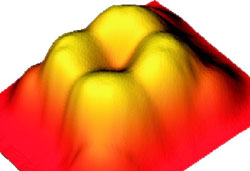STM Sees Motions in a Molecule

The scanning tunneling microscope (STM) can make impressive images of single atoms and molecules on surfaces; now it has been used to measure a molecule’s internal motion. A French and German team slid a large molecule along a surface and determined its flexing motions by measuring the so-called tunneling current between the molecule and the STM probe tip. They report their results in the 20 August print issue of PRL. Experts hope that the ability to control and follow these internal motions in such a large molecule will help them develop molecular scale devices.
Nanotechnology researchers have gotten good at imaging and moving single atoms and molecules on surfaces. Eventually they would like to build tiny machines by assembling them molecule-by-molecule, but they are still in the exploration stage: looking for new ways to observe and manipulate what Jim Gimzewski of the University of California in Los Angeles calls the “molecular Tinker Toy set.”
Francesca Moresco of the Free University of Berlin and her colleagues studied a molecule called TBPP, which is made from a large disk-shaped molecule with four bulky molecular groups attached to it. Deposited on a surface, TBPP looks something like a round table with four legs extending to the floor. The molecular groups extend above the disk as well and show up in the STM images of the molecule. Using an STM probe tip, the researchers pushed a TBPP molecule across a copper surface cooled to 12 K . “If you push a small molecule like CO across a crystalline surface, it simply hops over the rows of surface atoms,” says Moresco. “But a large molecule like TBPP has many more internal degrees of freedom, so you get local deformations coupled with a sliding motion.”
These deformations and conformational changes in the molecule result in tiny changes in the tunneling current. To interpret these fluctuations, the team simulated their experiment on a computer. They calculated the deformation of the molecule and the resulting change in tunneling current. Based on the simulation, Moresco and her colleagues determined the angle at which each leg sits on the surface and the motion of the legs during the molecule’s excursion along the surface. Two of the legs–the one in direct contact with the tip and the one directly opposite–perform a kind of oscillating motion along the direction of motion, while the other two simply move up and down according to the corrugations on the surface.
Earlier this year [1] the team showed that the STM tip could switch the orientation of a single leg of TBPP between two configurations–the basis for a possible future molecular “switch.” Gimzewski thinks the two papers taken together show real progress toward nanodevices. “This beautiful work really shows that we are beginning to learn the techniques,” says Gimzewski. “Now all we need is to chemically redesign the molecule and realize controllable devices.”
–Rob van den Berg
Rob van den Berg is a physicist and freelance science writer in Oegstgeest, the Netherlands.
References
- F. Moresco et al., Phys. Rev. Lett. 86, 672 (2001)


